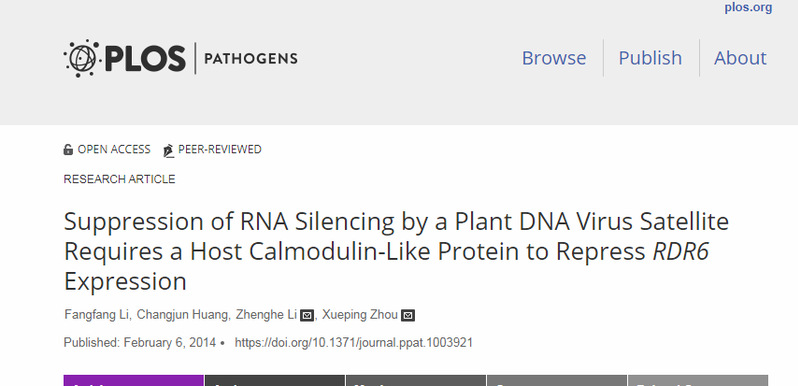RESEARCH
Current location:homepage RESEARCH PUBLICATIONS
PLOS PATHOGENS: Suppression of RNA Silencing by a Plant DNA Virus Satellite Requires a Host Calmodulin-Like Protein to Repress RDR6 Expression
DATE:2018-07-10
Suppression of RNA Silencing by a Plant DNA Virus Satellite Requires a Host Calmodulin-Like Protein to Repress RDR6 Expression
Fangfang Li, Changjun Huang, Zhenghe Li , Xueping Zhou
Abstract
In plants, RNA silencing plays a key role in antiviral defense. To counteract host defense, plant viruses encode viral suppressors of RNA silencing (VSRs) that target different effector molecules in the RNA silencing pathway. Evidence has shown that plants also encode endogenous suppressors of RNA silencing (ESRs) that function in proper regulation of RNA silencing. The possibility that these cellular proteins can be subverted by viruses to thwart host defense is intriguing but has not been fully explored. Here we report that the Nicotiana benthamiana calmodulin-like protein Nbrgs-CaM is required for the functions of the VSR βC1, the sole protein encoded by the DNA satellite associated with the geminivirus Tomato yellow leaf curl China virus (TYLCCNV). Nbrgs-CaM expression is up-regulated by the βC1. Transgenic plants over-expressing Nbrgs-CaM displayed developmental abnormities reminiscent of βC1-associated morphological alterations. Nbrgs-CaM suppressed RNA silencing in an Agrobacterium infiltration assay and, when over-expressed, blocked TYLCCNV-induced gene silencing. Genetic evidence showed that Nbrgs-CaM mediated the βC1 functions in silencing suppression and symptom modulation, and was required for efficient virus infection. Moreover, the tobacco and tomato orthologs of Nbrgs-CaM also possessed ESR activity, and were induced by betasatellite to promote virus infection in these Solanaceae hosts. We further demonstrated that βC1-induced Nbrgs-CaM suppressed the production of secondary siRNAs, likely through repressing RNA-DEPENDENT RNA POLYMERASE 6 (RDR6) expression. RDR6-deficient N. benthamiana plants were defective in antiviral response and were hypersensitive to TYLCCNV infection. More significantly, TYLCCNV could overcome host range restrictions to infect Arabidopsis thaliana when the plants carried a RDR6 mutation. These findings demonstrate a distinct mechanism of VSR for suppressing PTGS through usurpation of a host ESR, and highlight an essential role for RDR6 in RNA silencing defense response against geminivirus infection.


